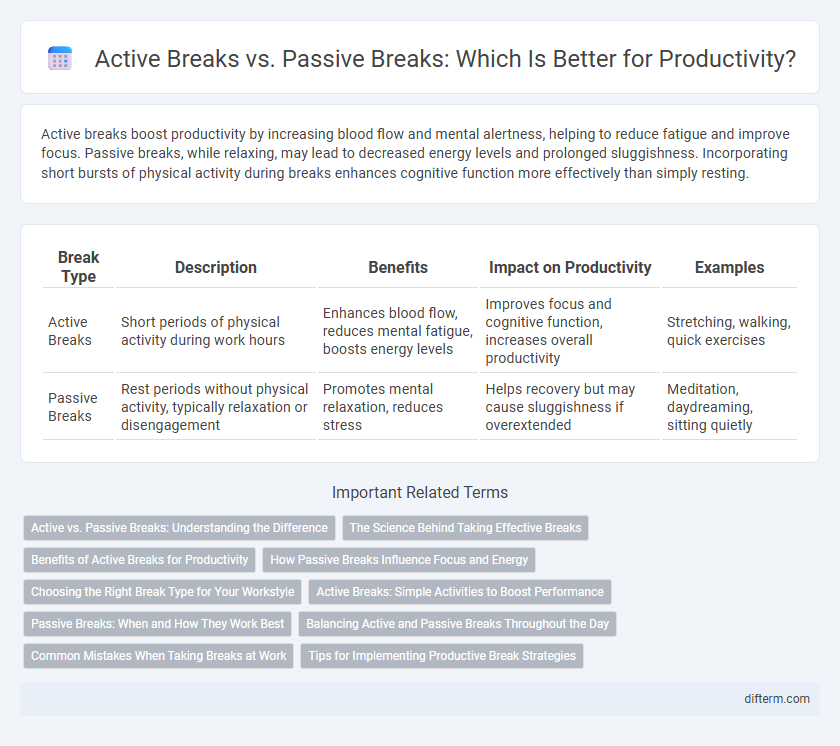Active breaks boost productivity by increasing blood flow and mental alertness, helping to reduce fatigue and improve focus. Passive breaks, while relaxing, may lead to decreased energy levels and prolonged sluggishness. Incorporating short bursts of physical activity during breaks enhances cognitive function more effectively than simply resting.
Table of Comparison
| Break Type | Description | Benefits | Impact on Productivity | Examples |
|---|---|---|---|---|
| Active Breaks | Short periods of physical activity during work hours | Enhances blood flow, reduces mental fatigue, boosts energy levels | Improves focus and cognitive function, increases overall productivity | Stretching, walking, quick exercises |
| Passive Breaks | Rest periods without physical activity, typically relaxation or disengagement | Promotes mental relaxation, reduces stress | Helps recovery but may cause sluggishness if overextended | Meditation, daydreaming, sitting quietly |
Active vs. Passive Breaks: Understanding the Difference
Active breaks involve physical movement or mental engagement, such as stretching or quick exercises, boosting blood flow and cognitive function. Passive breaks consist of resting or passive activities like sitting quietly or watching videos, which may help relaxation but do not stimulate alertness as effectively. Studies show active breaks improve productivity and focus more significantly than passive breaks by enhancing energy levels and reducing fatigue.
The Science Behind Taking Effective Breaks
Active breaks, such as stretching or light physical activity, stimulate blood flow and enhance cognitive function, leading to improved focus and productivity. Passive breaks, like resting or meditating, promote mental recovery and reduce stress, supporting sustained attention over long work periods. Neuroscience research reveals that alternating between active and passive breaks optimizes brain plasticity and prevents mental fatigue, maximizing overall work efficiency.
Benefits of Active Breaks for Productivity
Active breaks enhance productivity by increasing blood flow and oxygen to the brain, which improves focus and mental clarity. Engaging in physical activity during breaks reduces stress and fatigue, leading to sustained energy levels throughout the workday. Studies show that workers who take active breaks report higher concentration and task performance compared to those who take passive breaks.
How Passive Breaks Influence Focus and Energy
Passive breaks, characterized by activities such as resting or daydreaming, can help rejuvenate mental energy by reducing cognitive fatigue and promoting relaxation. These breaks facilitate memory consolidation and improve concentration when returning to tasks, enhancing overall focus. However, excessive passive breaks may lead to decreased alertness, so balancing them with active breaks is crucial for sustained productivity.
Choosing the Right Break Type for Your Workstyle
Choosing the right break type for your workstyle enhances productivity by aligning rest with cognitive demands; active breaks involving light physical activity boost energy and creativity, while passive breaks like meditation promote mental relaxation and stress reduction. Employees engaged in tasks requiring high focus benefit more from passive breaks to restore cognitive resources, whereas those handling repetitive or low-focus activities gain increased alertness from active breaks. Tailoring break types based on task complexity and individual energy patterns optimizes overall work performance and sustains attention throughout the day.
Active Breaks: Simple Activities to Boost Performance
Active breaks, such as stretching, walking, or light exercise, significantly enhance cognitive function and energy levels, leading to improved productivity throughout the workday. Engaging in these simple physical activities increases blood flow to the brain, reduces mental fatigue, and promotes better focus and creativity. Studies show that employees who incorporate active breaks experience higher work efficiency and reduced stress compared to passive rest periods.
Passive Breaks: When and How They Work Best
Passive breaks are most effective during periods of high cognitive fatigue, allowing the brain to rest and recover without additional stimulation. Activities such as light stretching, meditation, or simply sitting quietly help reduce mental exhaustion and improve focus upon returning to work. Research shows that these restful pauses enhance overall productivity by preventing burnout and promoting sustained attention.
Balancing Active and Passive Breaks Throughout the Day
Balancing active and passive breaks throughout the day enhances overall productivity by preventing burnout and maintaining mental clarity. Active breaks, such as stretching or walking, boost circulation and cognitive function, while passive breaks like meditation or deep breathing promote relaxation and stress relief. Integrating both types strategically supports sustained focus and energy levels during work hours.
Common Mistakes When Taking Breaks at Work
Common mistakes when taking breaks at work include opting for passive breaks such as scrolling through social media or watching videos, which can lead to mental fatigue rather than recovery. Active breaks involving physical movement or stretching improve blood circulation and cognitive function, enhancing overall productivity. Neglecting structured break schedules often results in burnout and reduced focus during work hours.
Tips for Implementing Productive Break Strategies
Incorporate active breaks by integrating short exercises such as stretching or walking to boost blood flow and mental alertness, enhancing overall productivity. Schedule these breaks every 60 to 90 minutes to prevent burnout and maintain focus throughout work sessions. Use tools like timers or productivity apps to remind you of breaks, ensuring consistency and promoting a balanced work routine.
active breaks vs passive breaks Infographic

 difterm.com
difterm.com